This easy oven roasted turkey breast is a flavor-packed smaller dish alternative to a whole turkey for Thanksgiving!
I provide loads of tips to achieve PERFECTLY cooked, tender, juicy, succulent, oven roasted turkey breast. Without ever running the risk of over-cooking or drying out the meat.
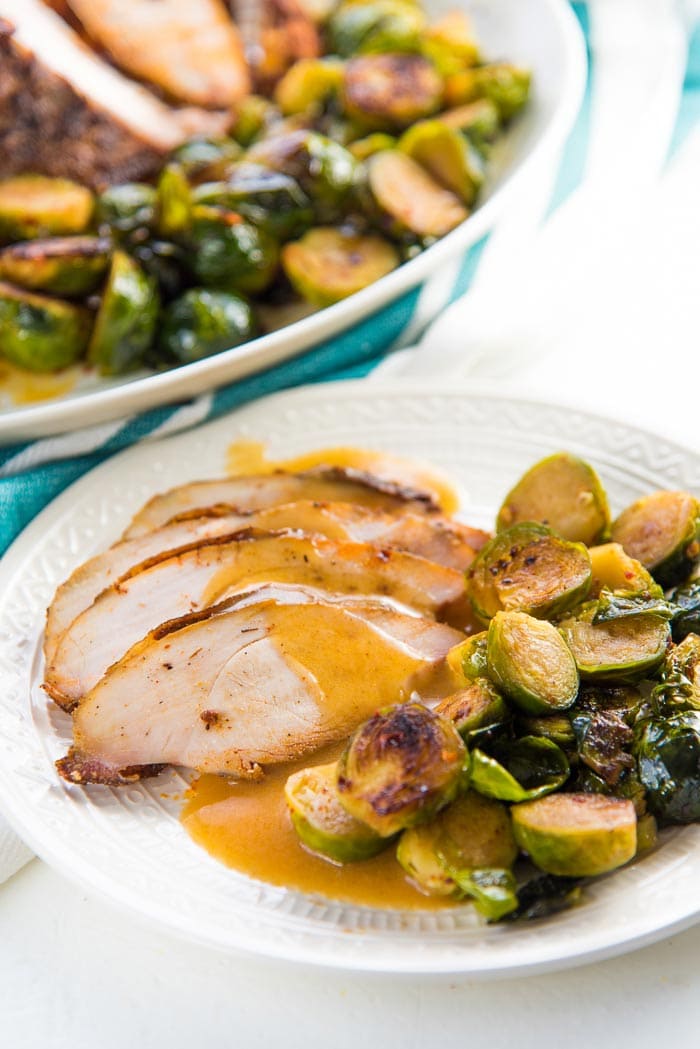
- Ingredients for this oven roasted turkey breast recipe
- How to buy turkey breast at the store for this recipe
- How to make oven roasted turkey breast
- Tips to prevent the turkey breast from drying out and ensure tender, juicy, succulent results
- Flavor variations
- Storage instructions
- How to serve this slow roasted turkey breast
- What to do with leftovers
It’s Thanksgiving week in The Flavor Bender household! 🙂
Which means I’m sharing some of my favorite Thanksgiving recipes with you guys this week! If you’re looking for more amazing turkey breast recipes (and whole bird alternatives), you can check out my perfect slow cooker turkey breast as well, and for something a little fancier, learn how to make a turkey roll (turkey roulade)!
And then make a perfectly slow roasted turkey roll or a sous vide turkey roll. For other meat and flavor alternatives, check out my sous vide roast beef (sous vide chuck roast), slow braised pork roast, slow roasted salmon, honey roast lamb, and green curry roast chicken.
If your family is small (like mine), and a whole turkey is just too much food, OR if you want extra turkey for a smaller group and a whole second bird is too much, a smaller turkey breast roast like this is absolutely perfect.
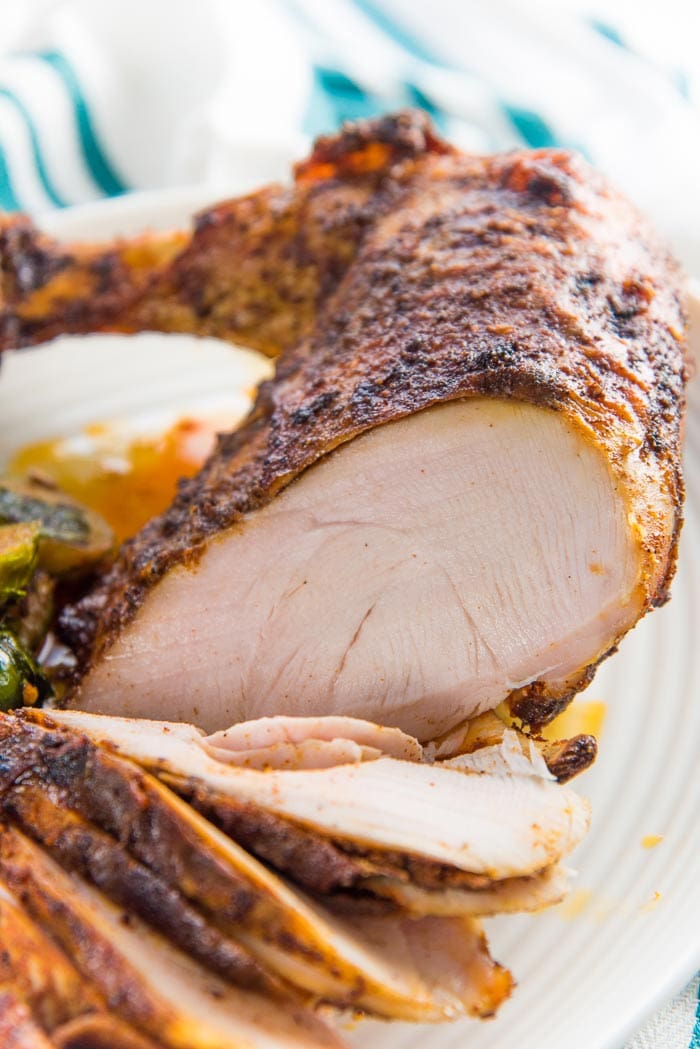
Why you’ll love this oven roasted turkey breast recipe
- The main issue with oven-roasted turkey breast is the meat drying out during the cooking process, so that you end up with roasted turkey breast that tastes like cardboard. But not with this recipe!
- Here, I’ll share ALL the tips on how to cook a turkey breast – tender, juicy, succulent, perfectly cooked roasted turkey breast that’s full of flavor and easy to prepare! Just check out how JUICY that turkey roast is (see the photo above!). It’s unbelievably good!
- The breast cut of poultry is obviously more prone to drying out during cooking, but it’s also the more healthy cut of the meat, because the breast cut has less fat, and relatively more protein as well.
- I explain how to choose the right cut of breast meat for your needs. Taking into account the ease of cooking, time to cook, consistently perfect results, and of course flavor!
- I provide incredible flavor options for you turkey breast roast too. A spicy cajun version, and a more classic herbed version using fresh herbs.
- Instead of struggling with a whole bird, roasting a turkey breast takes less time and effort, but with delicious results! Plus, you can always make several with different flavors.
But first things, first.
Ingredients for this oven roasted turkey breast recipe
The flavors that you can use to make this easy roasted turkey breast are endless! But my husband and I love spicy food. So it’s no surprise that I opted for a cajun spiced, slow roasted turkey breast here.
For the roast
- Turkey breast, bone in, skin on.
- Salt to season
- Cajun seasoning (I used homemade cajun spice, which has no added salt or sugar)
- Sugar or honey (remove if your seasoning includes sugar)
- Vegetable oil or melted butter
- Chicken stock
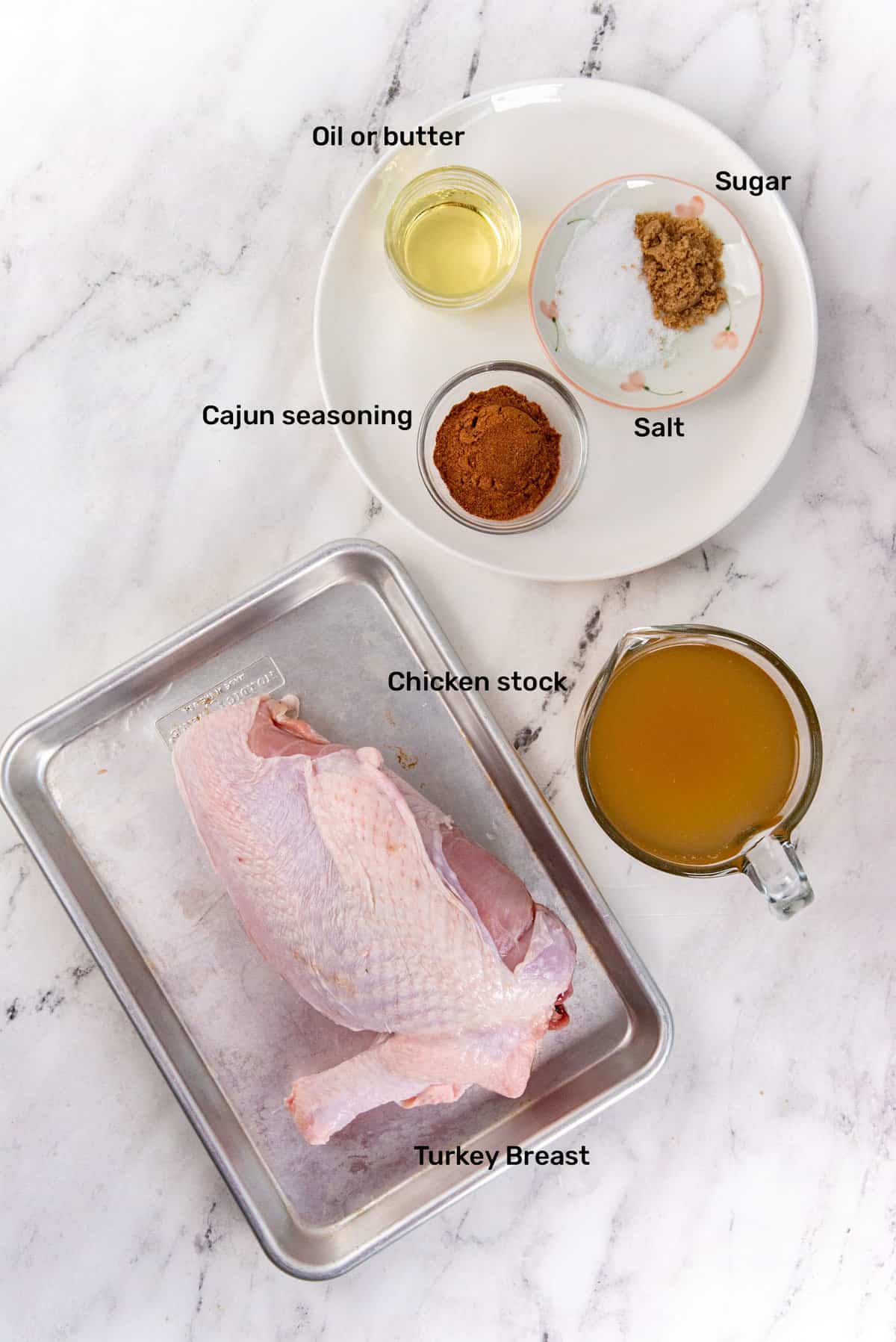
For the gravy
- Butter
- Flour
- Au jus from turkey roast
- Chicken stock
- Salt and pepper to taste
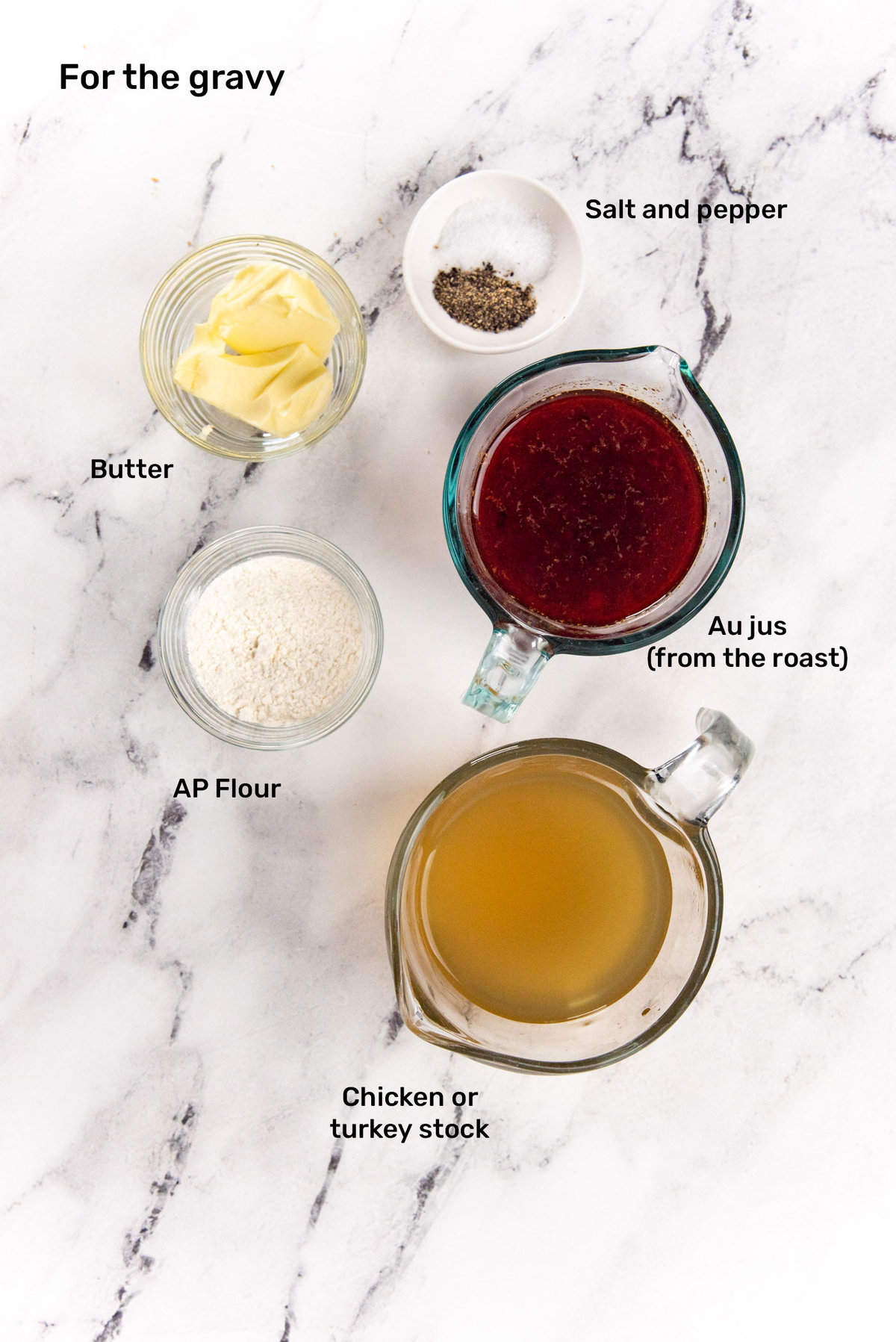
How to buy turkey breast at the store for this recipe
Bone-in or boneless turkey?
I used a bone-in turkey breast here, with the wing drumette attached. This actually makes the turkey breast look like a massive leg roast! This cut is also called a Frenched breast cut.
You can ask your butcher to prepare this cut for you. HOWEVER, you can use other turkey breast cuts as well.
- A skin-on boneless turkey breast with the drumette (still called a Frenched breast cut).
- A skin-on boneless turkey breast without the drumette.
- Turkey crown – i.e. both turkey breasts, skin-on and bone-in (may take longer to cook).
- Skin-on, boneless turkey breast roll up (prepared cuts you can buy from the supermarket).
I do find that bone-in turkey breasts have extra flavor, and the chances of overcooking are less. Boneless turkey breast roast can overcook and dry out faster because,
- Uneven meat (thicker at one end and smaller at the other end).
- No bone to act as an insulation.
However, boneless turkey breasts are of course easier to cut and serve. And there are ways to ensure perfect results with boneless turkey breasts as well.
How to choose a turkey breast
Bone-in turkey breast
- Look for a bone-in turkey breast. The bone will add more flavor as the turkey roasts, and act as an insulator to prevent the turkey from drying too quickly.
- Make sure the turkey breast has the skin on as well. The skin will also act as an insulator. Plus, you can add butter and other seasoning between the skin and the meat which will keep the breast moist for even more flavorful turkey.
- If not skin, you can also use bacon slices.
- All these points apply to both whole turkey breast (double breast) and half breast (single breast).
Boneless turkey breast
- If you do buy a boneless turkey breast from the store, you can roast it as it is. However, there are a few tips you can follow to ensure the breast roast will not dry out too much.
- Turn the turkey breast into a roulade! A turkey roulade (or turkey roll) is a piece of turkey that has been shaped into a cylinder / roll. The thickness of a roulade is consistent throughout the whole roast. This means that the meat will cook more evenly throughout.
- You can purchase rolled turkey breast (or roulade) from the supermarket as well, or ask your butcher to do it for you. However, I have a comprehensive tutorial on how to turn a turkey breast into a roulade with step by step detailed instructions.
- Cover the roulade with the turkey skin, OR use bacon to keep the moisture trapped inside, and to act as an insulator.
- All these points apply to both whole breast and half breast.
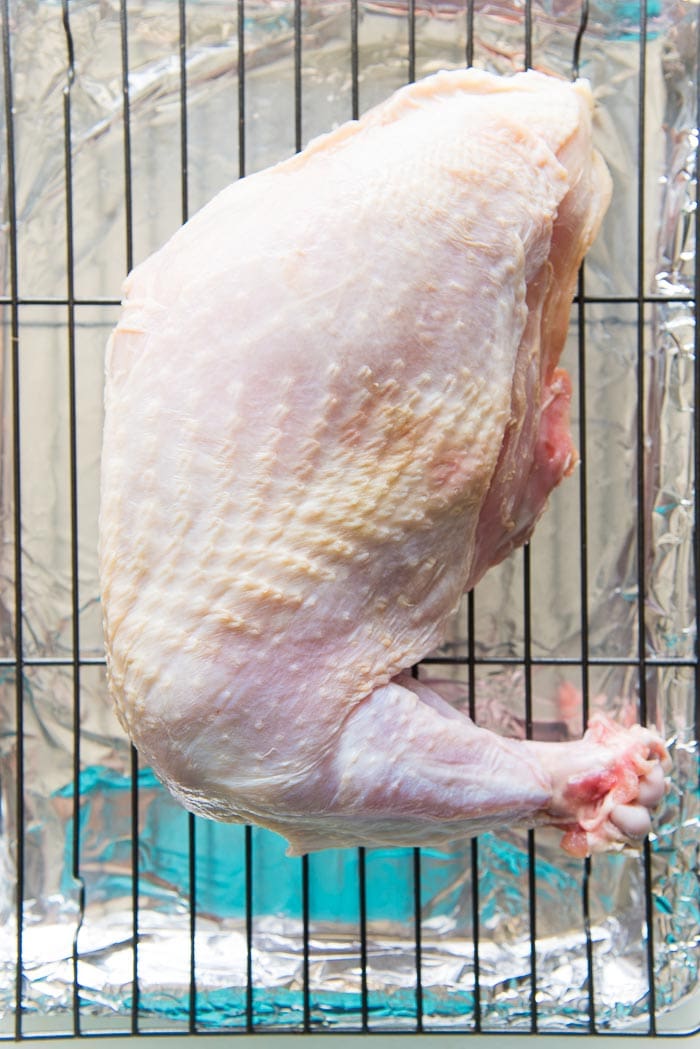
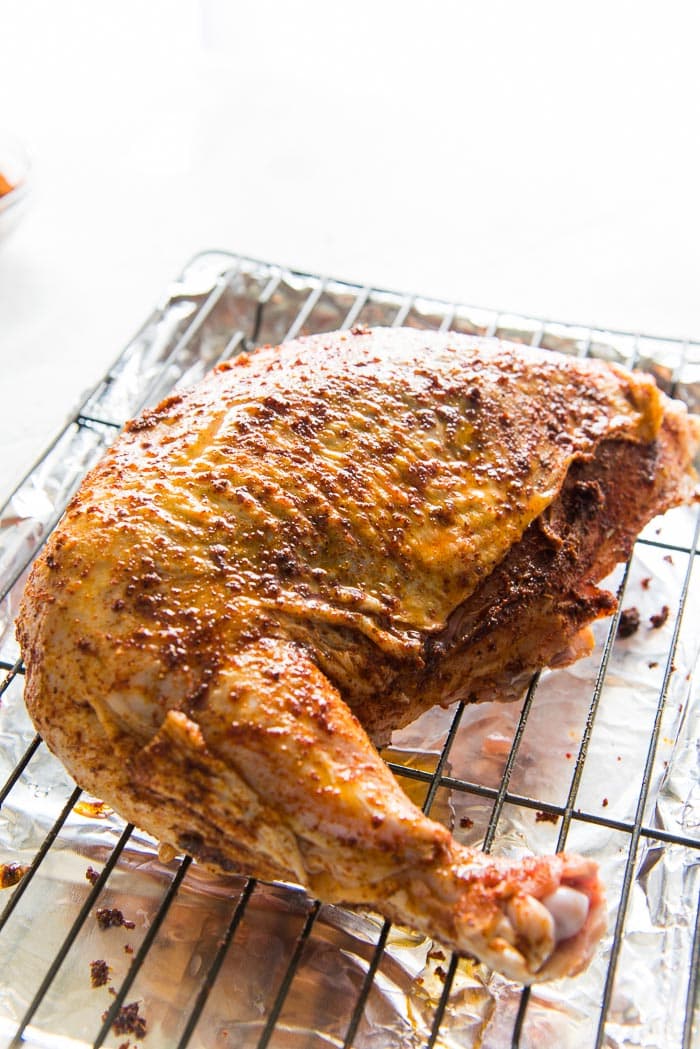
How much turkey breast per person?
When buying an uncooked turkey, choose the weight of the turkey by the pound depending on how many servings you will require.
½ pound per person for boneless uncooked turkey
¾ – 1 pound per person for bone-in uncooked turkey (this takes into account the bones and other inedible parts of a bone in turkey breast cut).
Since this recipe is for a bone-in turkey breast, for 2 people, you will need a minimum of 1.5 lbs, and 3 lbs for 4 servings.
I like to cook a little extra so that there is more than enough if anyone is hungrier than usual, and to ensure we have leftovers.
Not that I usually keep count, but I would expect, generally, one person to eat about 6-7 oz of cooked turkey meat per meal, along with other side dishes. But of course, this can be quite variable, so please use your discretion.
Whole breast or half breast?
This entirely depends on how much turkey you require, and how big your oven is.
One turkey breast (or half breast) is usually about 3 lbs with the bone-in. This will serve 2 – 4 people.
If you need to serve more than 4 people, it’s better to use a whole turkey breast (two breasts).
A bone in whole turkey breast crown can be baked in the oven, and it will generously serve 6 – 8 people (6 – 7 lbs).
However, you can also roast two separate turkey breasts if,
- Your oven doesn’t have enough room.
- You want to make two turkey roasts with two different flavors.
- To have the turkey breast cook faster.
Instead of a bone in turkey breast, you can also cook a boneless turkey breast the same way.
Just make sure to follow as many of my tips as you can to prevent the turkey from drying out if you’re cooking boneless turkey breast.
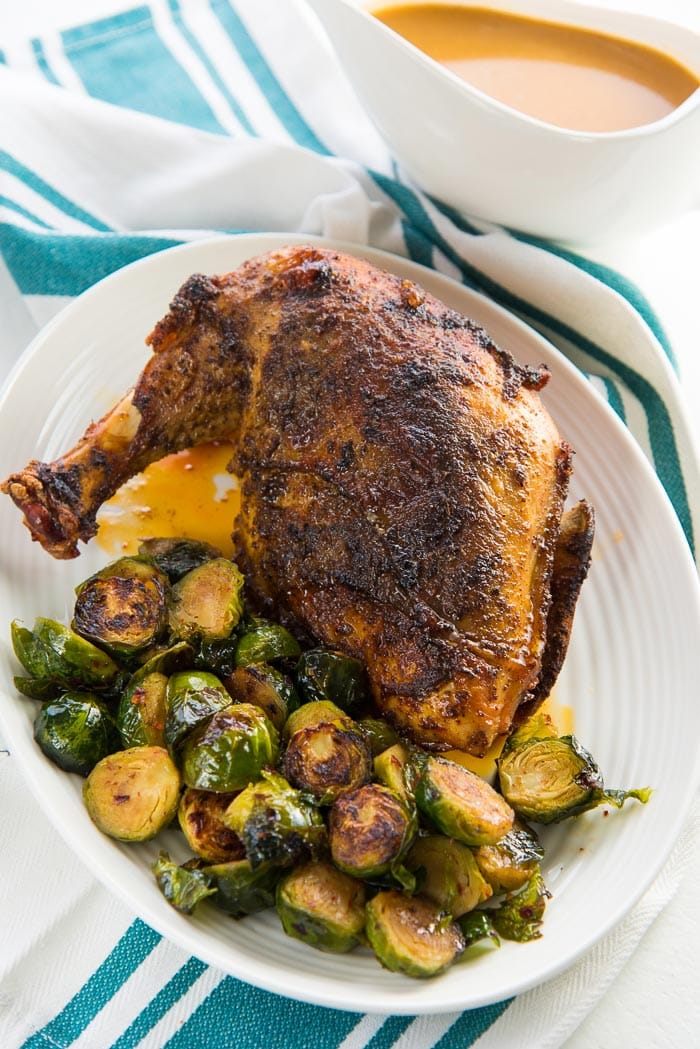
How to make oven roasted turkey breast
How to prepare the turkey breast for roasting
For thanksgiving, I would absolutely do everything possible to get the best results for my turkey! After all, the turkey is the star of the show.
This is how I prep my turkey breast for roasting.
The first step is to marinate the turkey breast, so that it’s plenty flavorful.
Sprinkle salt all over the turkey breast – Under the turkey and between the skin and meat of the turkey breast. Also sprinkle a little on top of the skin, but not too much as it might become too salty.
Cover the turkey breast and let it marinate for 2 – 3 days in the fridge. You can also uncover the turkey breast and let it marinate in the fridge. This will dry out the skin, which will also help with creating a lovely crispy skin after it’s cooked.
One the day (or a day earlier), make the cajun rub. Pat dry the turkey breast, so that the spices will stick to it really well. Spread this paste under the skin of the turkey breast, and under the breast, and the remaining amount over the skin.
When roasting the turkey breast, make sure that there is some air circulation under the turkey breast. To achieve that, place a wire rack on a baking sheet, and then place the turkey breast on the wire rack.
Place chicken stock in the baking sheet as well. The stock will evaporate and help keep the turkey breast moist as it bakes.
Loosely cover the top of the turkey breast. This will help to keep the turkey breast moist as well.
Keep the pan drippings to make the turkey gravy. Those pan drippings are delicious and will make the most amazing gravy!
Best temperature to roast this turkey breast
To keep the turkey moist, it’s best to cook the turkey breast roast slowly, at a lower temperature.
This will ensure that the turkey meat cooks as evenly as possible, slowly, for a longer period of time. In this recipe, the turkey breast is cooked at 300 F. You could even lower the temperature to 275 F, but this will increase the baking time needlessly. There are other recipes that set the oven to 325F, but I prefer the results at 300F, even if it does take a little longer.
300 F is a good balance between low oven temperature and longer cook time. If you do want the turkey breast roast to cook faster, then increase the oven temp. to 325 F.
To get that nice crispy skin at the end, we will increase the oven temperature to quickly caramelize the skin.
The trick to achieve the juiciest turkey breast is to cook the meat to an internal temperature of 160 F inside the oven (the internal temperature will continue to rise with residual heat).
How long to roast the turkey breast
The cook time for turkey breast roasts will vary depending on the size of the breast, thickness of the breast roast, and the starting temperature of the turkey breast.
Usually, it’s estimated that 1 lb of turkey will take about 20 – 30 minutes at 325 F. Since I bake it at 300 F, this time will increase to about 30 – 40 minutes.
For a 3 lb turkey breast at 300 F, it takes me about 2 hours.
I always check the internal temperature of the turkey breast with an instant read thermometer inserted into the thickest part of the breast. Once this registers at 160 F, then I know the turkey is done!
Let the slow roasted turkey rest while still covered, for at least 20 minutes. This helps to keep the turkey roast moist by not letting any pan juices evaporate, and the resting meat reabsorbs extra juices as well.
Once roasted, and rested, turn on the broiler of the oven, and broil the turkey breast to caramelize the skin.
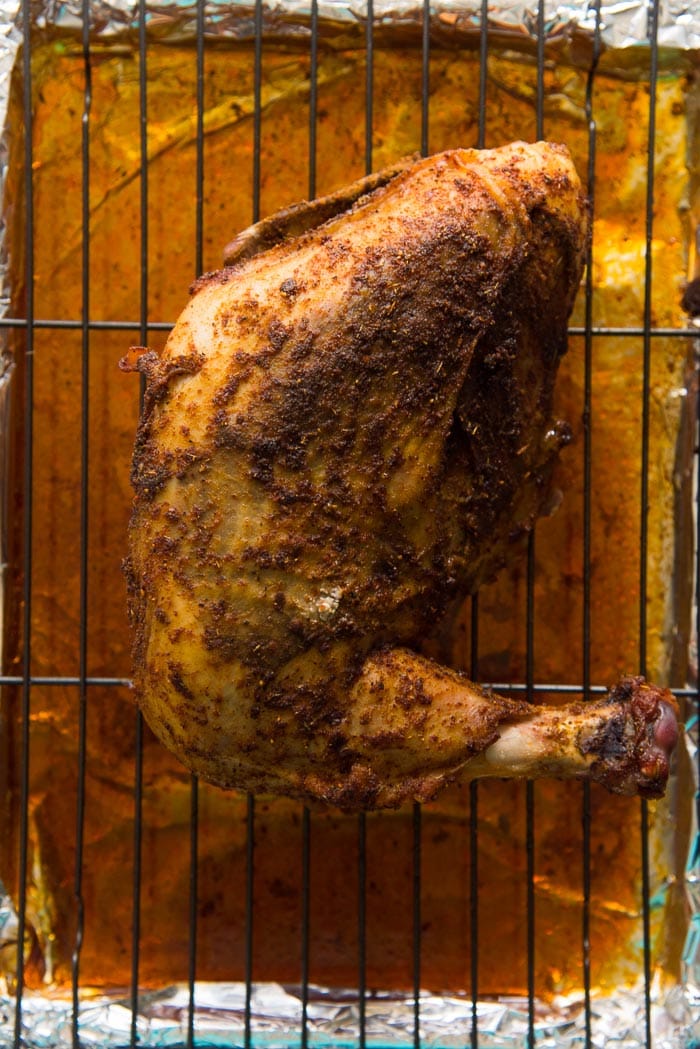
Tips to prevent the turkey breast from drying out and ensure tender, juicy, succulent results
I use three methods to make sure this cajun roasted turkey breast doesn’t dry out during cooking.
1. Let the turkey breast marinate for a day (or even two). If you’re using either a dry rub or a wet rub, you can apply this the day before as well. I prefer to just season the meat with salt, on both sides, including under the skin, and let it sit in the fridge until I’m ready to roast the turkey.
2. Low and slow cooking method. I slow roast this turkey breast in the oven at no more than 300°F. The low temperature allows the turkey roast to heat slowly, so you have more control over the cooking process. And you can remove it from the oven when the internal temperature registers 160°F (the internal temp. will continue to rise even after the meat is removed from the oven).
3. Add liquid to the roasting pan, so that there’s a constant supply of moisture as the roast turkey breast cooks. I cover the entire piece of meat in aluminum foil as it cooks in the oven, while the moisture envelops the roast as it cooks.
4. Use a cooking thermometer. A cooking thermometer IS A MUST! These are quite inexpensive, so it makes perfect sense to have one for guaranteed results. My temperature probe is the most utilized kitchen tool, next to my mixing spoons and pots.
Turkey breast dries out quickly as it goes past 165°F. With a temperature probe, you will know precisely when to remove the meat from the oven, eliminating over-cooking and the meat drying out.
A cooking thermometer will open up new culinary possibilities for you, while guaranteeing perfect results for often made dishes like steak, other roasts, fish, and even candies like marshmallow. It’s such a handy tool to have in your kitchen and I very highly recommend it!
5. Go by internal temperature. Since turkey breasts can vary in size, it’s important to go by internal temperature to make sure your turkey breast is perfectly cooked and food-safe. The turkey breast I’m showing in this post was on the small-ish side, about 3 lbs. If you are using dark meat, the turkey should be cooked to 165 F. However for turkey breast (white meat), an internal temperature of 160 F is sufficient, but you can also go up to 165 F. The resting time will continue to cook the turkey breast so that the temperature will continue to rise from 160 F and doesn’t go past 165 F.
6. I prefer to cook the turkey breast on a wire rack, over a cooking pan that has liquid in it. The steam that this liquid generates helps to keep the turkey breast moist. I prefer to use a very flavorful liquid for this purpose, like stock with butter or oil, or even white wine sometimes. The steam also allows the meat to cook evenly because of air/moisture circulation, without getting a terribly soggy turkey breast bottom.
7. Cover the turkey breast with foil, while cooking. This also prevents the turkey breast from overcooking or drying out. This way you don’t have to keep basting the turkey breast while it’s cooking either.
8. Caramelize the skin under the grill/broiler. I like to allow the roasted turkey breast to cool down before broiling the skin. This is because when the turkey breast has cooled down sufficiently, caramelizing the skin under the broiler won’t dry out the meat on the inside. And since this is the very last step before prepping the oven roasted turkey breast for Thanksgiving, I know the roast turkey breast will be perfectly warm and delicious with crispy, caramelized skin when I’m ready to serve it.
I promise you this method of cooking turkey breast will guarantee perfectly cooked, deliciously succulent results!
How to accurately check internal temperature with thermometer
This is true for any roast. ALWAYS insert the meat thermometer into the thickest part of the roast to get an accurate reading.
If you’re using an instant-read thermometer, you will usually get the reading within a couple of seconds. Other types of thermometers may need a few seconds to register the right temperature. Allow time for the thermometer to reach the correct temperature.
I always remove roasted turkey breast from the oven when the internal temperature hits 160°F.
The turkey breast requires 20 seconds at this temperature to reach the food safety mark, and by keeping the turkey breast covered after removing it from the oven, the internal temperature continues to rise, making the meat perfectly food safe, while also ensuring tender and succulent results!
Flavor variations
I used a delicious cajun spice mix to flavor this slow roasted turkey breast. You can use any spice mix of your choice.
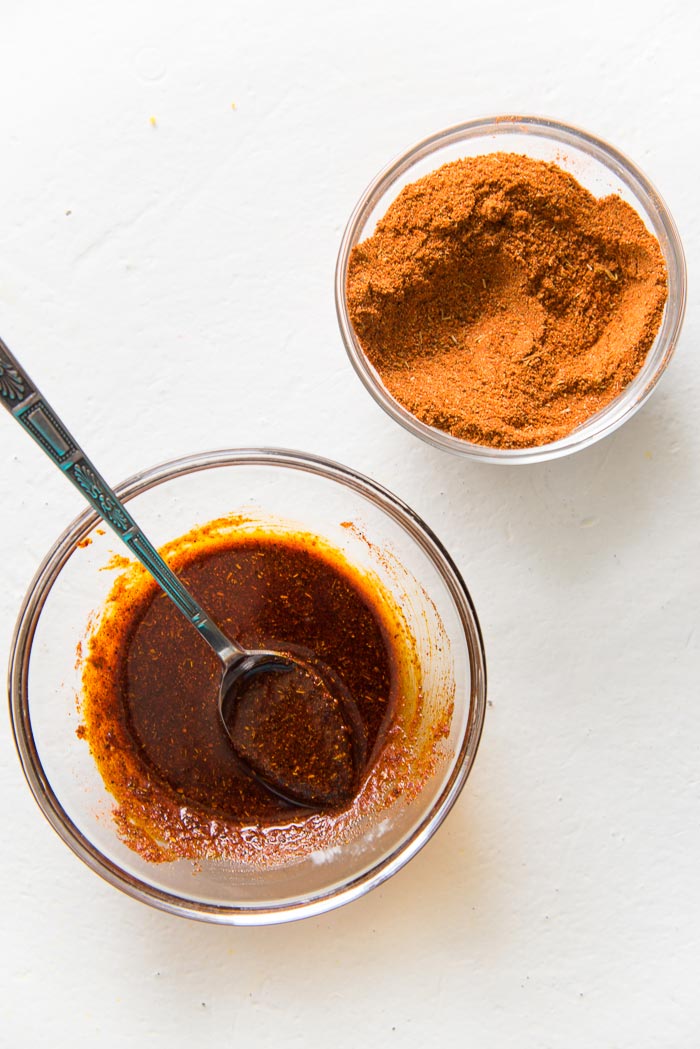
Here are some spice mix options for this oven roasted turkey breast
- Herb and garlic mix that I used for this sous vide turkey roll.
- Sage and rosemary mix that I used for this slow roasted turkey roll.
- A little different, but delicious nonetheless – green curry spice mix that I used for this green curry roast chicken.
- And if nothing else, just a simple salt and black pepper spice mix will be just as great!
Adding a little extra butter or oil will make this cajun roasted turkey breast even juicier. Slow roasting is a very straightforward way to make sure that you get tender, juicy meat that is full of flavor, while perfectly caramelizing the skin too.
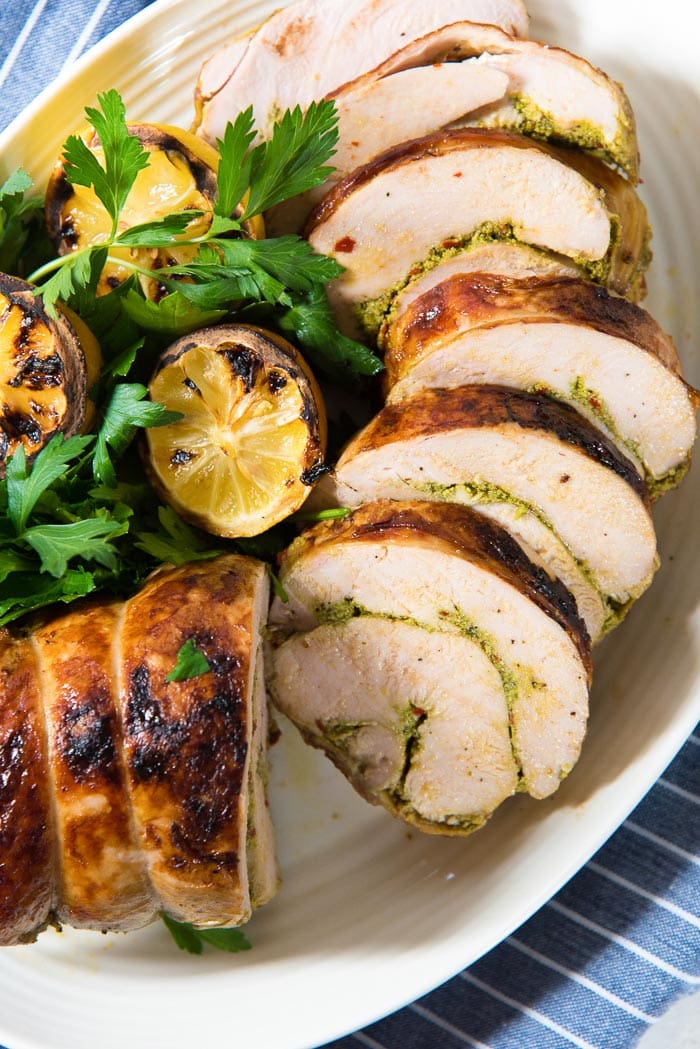
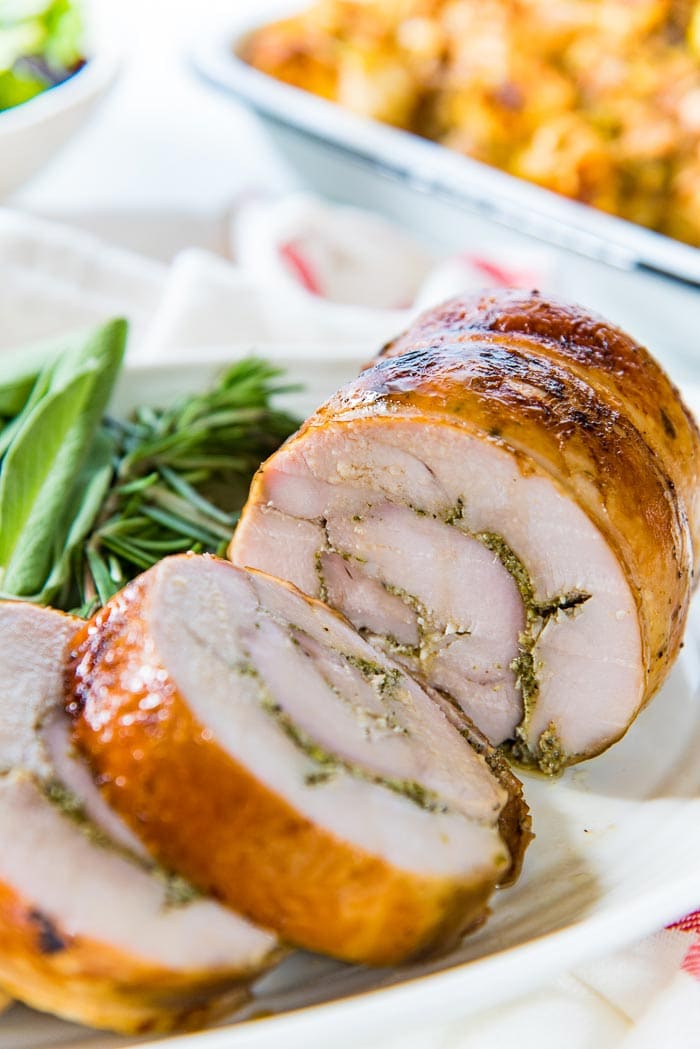
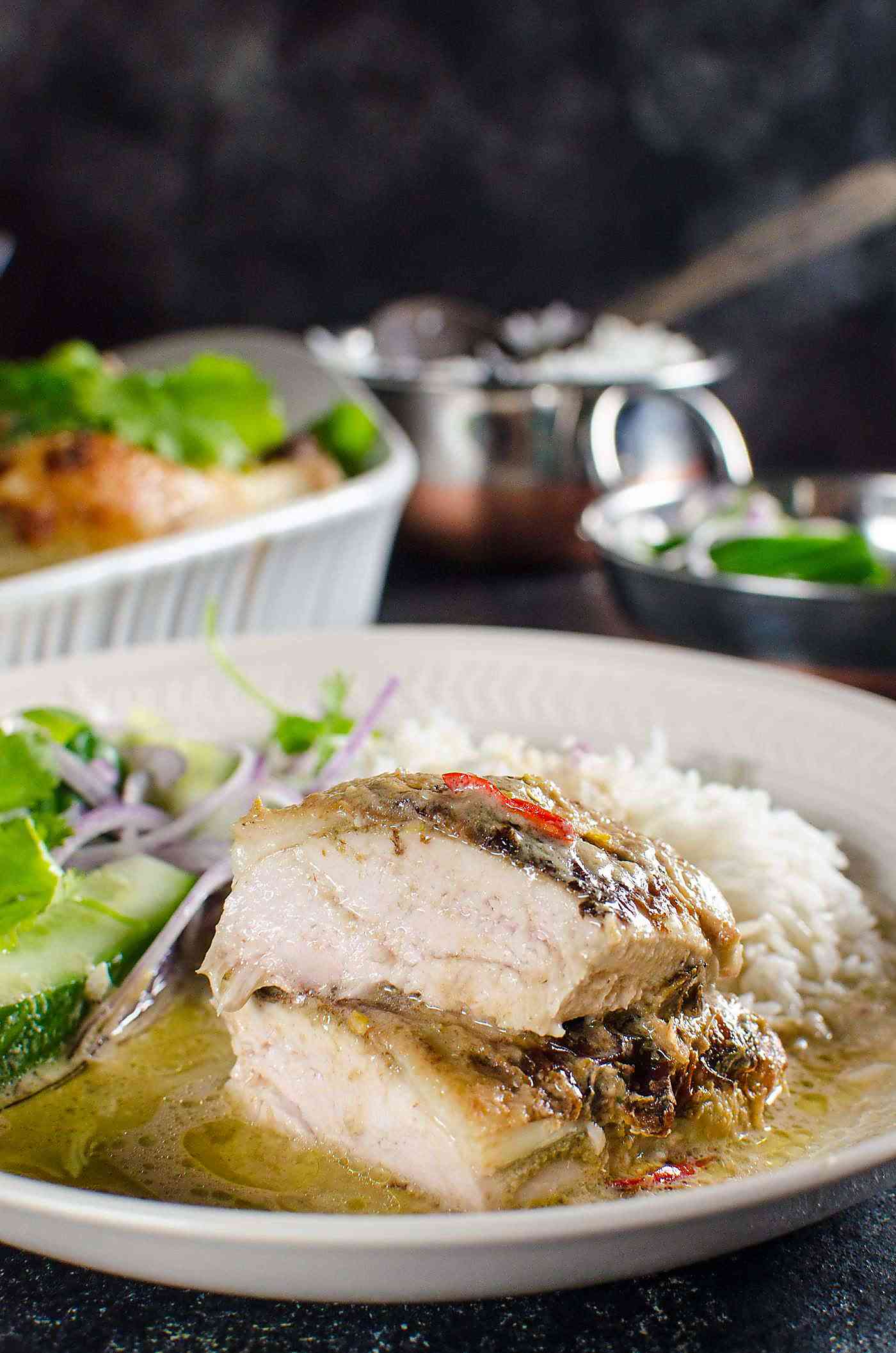
Storage instructions
This turkey roast can be made ahead of time. So, if you choose to roast the turkey the day before, place the slow roasted turkey breast in an airtight container. When you do so, make sure that it has cooled down to room temperature, and is still covered by foil.
The following day, let the roast come to room temperature before serving, and broil the turkey breast for a few minutes to caramelize the skin.
If the turkey breast is very large, you may need to reheat the roast in the oven (while covered with foil).
To store leftovers, place the turkey in an airtight container and store in the fridge for up to 4 days. Always check the turkey before consuming. If there is any change in smell, texture, or color of the turkey, please discard.
I personally like to slice the turkey breast and then save what I know I can eat within 2 days in the fridge. The rest, I wrap in parchment paper and foil, and then freeze for up to 3 months! This way I only remove the portions I want, and keep the rest frozen in the freezer until needed.
How to serve this slow roasted turkey breast
Other turkey mains
- If you like slow roasted turkey – this roast turkey breast is perfect, or for something a little fancier, you can try my slow roasted turkey roll here.
- If you have a sous vide, then you can make the juiciest turkey roast (because you cook it at a lower temperature for longer in a sous vide), by following this sous vide turkey roll recipe here.
- Prefer slow cooking turkey breast instead? Then try my perfect slow cooker turkey breast.
Sides
Here are some delicious traditional Thanksgiving side dishes and other sides to serve with this juicy turkey breast.
- Pear, sage and sausage stuffing
- Cranberry sauce
- Maple roasted brussels sprouts
- Cheddar corn biscuits
- Green bean stir fry
- Creamy cajun chicken pasta
- Roasted delicata squash
- Panzanella salad
- Crispy cheese jalapeno bacon bites
Desserts
If you’re serving this for Thanksgiving, then here are some amazing seasonal dessert recipes to pair with this roast turkey breast recipe.
- Crustless pumpkin pie
- Classic pumpkin pie
- Butterscotch apple pie
- Pavlova
- Bourbon butter pecan cake
- Spiced pumpkin cheesecake
- Pumpkin roll cake
- Fudgy pecan pie bars
- Fudgy s’mores brownie pie
- Brownie bottom pumpkin cheesecake
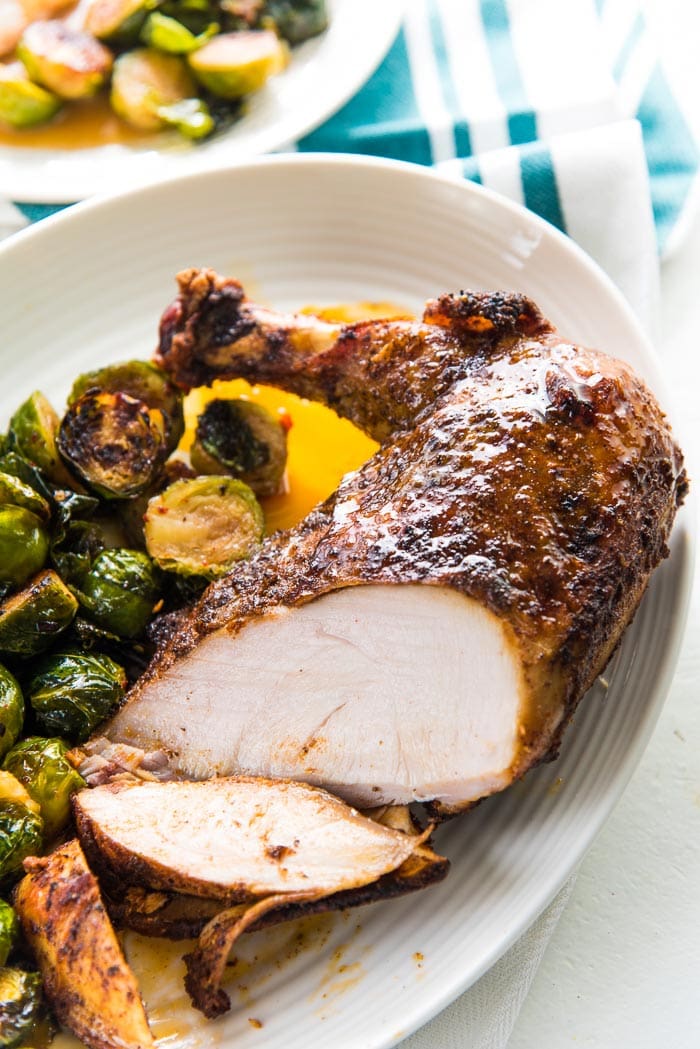
What to do with leftovers
There are so many options for roasted turkey breast leftovers. Here are some of my favorites.
- Thanksgiving leftover strata
- Leftover turkey sandwich
- Creamy turkey shepherd’s pot pie
- Turkey croque monsieur
- Turkey filo rolls
- Thanksgiving leftover savory bread pudding
Tools I recommend for this recipe
Cooking thermometer – I have two types. A probe that I can keep IN THE MEAT while it cooks, and an instant read thermapen. I use them interchangeably. This thermopro thermometer is affordable and very versatile, with a timer as well as a temperature alarm as well. I have two and use them all the time.
Whisks – You will need a good whisk to make the gravy, to make sure there are no lumps.
Small roaster pan with a rack – You can buy a roaster pan that’s dedicated for roasting smaller cuts of meat, OR you can use your quarter sheet pan, with a wire rack that fits over it as well. Either option is great for this Cajun roasted turkey breast recipe.
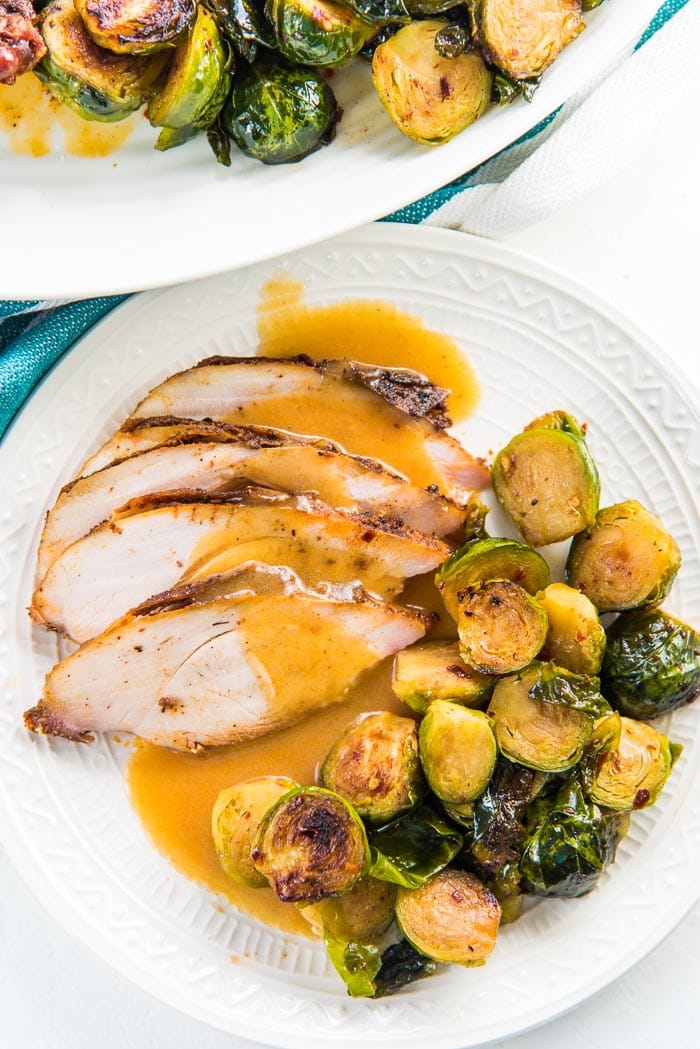
Looking for more recipes?Sign up for my free recipe newsletter to get new recipes in your inbox each week! Find me sharing more inspiration on Pinterest and Instagram.
Oven Roasted Turkey Breast
Ingredients:
Roast turkey breast
- 1 turkey breast skin on (can be bone in or boneless), about 3 lbs
- Kosher salt to season
- 3 tbsp cajun seasoning I used homemade cajun seasoning with no added salt or sugar
- 1 tsp sugar or honey adjust if your cajun seasoning has sugar
- 4 tbsp vegetable oil or melted butter
- 2 cups unsalted chicken stock or vegetable stock or turkey stock
- Extra oil or melted butter to be used when broiling the turkey breast
Turkey roast gravy
- 3 tbsp flour
- 3 tbsp butter
- Leftover turkey roast jus
- 2 cups turkey or chicken stock enough stock to make up 2 – 2 ½ cups of liquid (and more if needed)
- Salt and pepper to taste
Other equipment
- Quarter sheet pan lined with foil to make clean up easier
- A wire rack that fits inside the sheet pan
- Meat thermometer
- Basting brush
Instructions:
Turkey breast
Prepping the turkey breast
- Place the turkey breast on a plate and sprinkle kosher salt over the whole turkey breast (make sure to sprinkle salt under the breast, as well as under the skin. Lift the skin carefully when you do this, making sure not to tear or detach the skin from the beast). You can sprinkle a little salt over the skin as well, but not too much. Cover the plate with plastic wrap and leave the turkey breast to marinate in the fridge overnight, or up to 2 – 3 days.1 turkey breast, Kosher salt to season
Roasting turkey breast
- On the day you're roasting the turkey breast – remove the turkey breast from the fridge at least an hour before you plan to roast it. Pat dry the turkey breast with paper towels.
- Mix the cajun spice rub, sugar, and vegetable oil together to make a spice paste. Rub ½ of the paste under the turkey breast skin. Rub a little of the spice paste over the skin, and then rub the rest of the paste on the bottom of the turkey breast, and sides, making sure the breast is completely covered with the cajun spice paste.3 tbsp cajun seasoning, 1 tsp sugar or honey, 4 tbsp vegetable oil or melted butter
- Preheat your oven to 300°F / 150°C. Line a quarter sheet pan with foil and place a wire rack over the sheet pan. Pour about 1 cup of the stock into the quarter sheet pan and place the marinated turkey breast on the wire rack.2 cups unsalted chicken stock, Quarter sheet pan, A wire rack that fits inside the sheet pan
- When the turkey breast has reached room temperature, cover just the turkey breast with foil and transfer it to the preheated oven to cook.
- Check on the turkey and pan drippings at 60 minutes. If the liquid is low, add the other cup of stock as well.2 cups unsalted chicken stock
- Check the temperature of the turkey breast after 1.5 hours. Insert the meat thermometer into the thickest part of the roast to check the internal temperature. Check every 10 minutes or so at this stage, until the temp. registers 160°F (this takes about 2 hours for me in my oven).Meat thermometer
- Remove the turkey breast from the oven and keep it covered with foil for at least 20 minutes.
- MAKE AHEAD – If you'd like to cook this turkey breast roast ahead of time to save time on Thanksgiving/Christmas day, STOP HERE AT THIS STEP. Then once the turkey has cooled down, wrap the roast and place it in an airtight container, in the fridge for up to 2 days. Put the roast turkey drippings in a separate container/bowl to make gravy with it later.
Before serving the roast (on the day of)
- If you kept the turkey roast in the fridge, remove it at least 40 minutes before grilling to let the roast come to room temperature.
- Preheat the broiler/grill to high, and position the oven rack in the upper ⅓ of your oven.
- Place the turkey roast on a foil covered roasting pan (or quarter sheet pan), and drizzle some oil/melted butter over the surface, and brush it on evenly.Extra oil or melted butter, Basting brush
- When the broiler is preheated and ready – place the pan with the roast under the broiler for a few minutes, just until the turkey roast caramelizes on the surface. (If parts of the turkey roast are caramelizing too fast, use a piece of foil to cover that area, and continue to broil until the roast is evenly caramelized).
- This can take 5-10 minutes, and you MUST KEEP AN EYE ON THE ROAST AS IT BROILS, to prevent it from burning.
- When ready, remove the roast from the oven and serve with other side dishes and turkey gravy.
Turkey gravy
- Measure how much pan drippings you get from the turkey roast in a measuring cup.
- Add enough turkey stock/broth (or chicken stock/broth), to make 2 cups of liquid.2 cups turkey or chicken stock, Leftover turkey roast jus
- Place the butter in a pot and let it melt over medium heat. When the butter has melted, add the flour and whisk until there are no lumps in the flour. Keep stirring this roux until the color changes to brown, and it smells quite nutty.3 tbsp butter, 3 tbsp flour
- Whisk in the stock and pan drippings and continue to whisk until there are no flour lumps. Bring the gravy to a boil and then lower the heat. Cook until you have a gravy with a desired consistency. If the gravy becomes too thick, you can add more stock to thin it out. Taste the gravy and season with extra salt if needed.Salt and pepper to taste
- Pour the gravy into a bowl and cover with plastic wrap. Make sure the plastic wrap is touching the surface to prevent any gravy skin from forming on top.
Tips & Tricks
Nutrition Information:
“This website provides approximate nutrition information for convenience and as a courtesy only. Nutrition data is gathered primarily from the USDA Food Composition Database, whenever available, or otherwise other online calculators.”
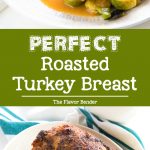
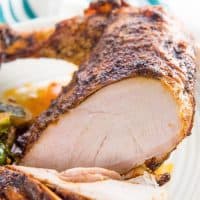
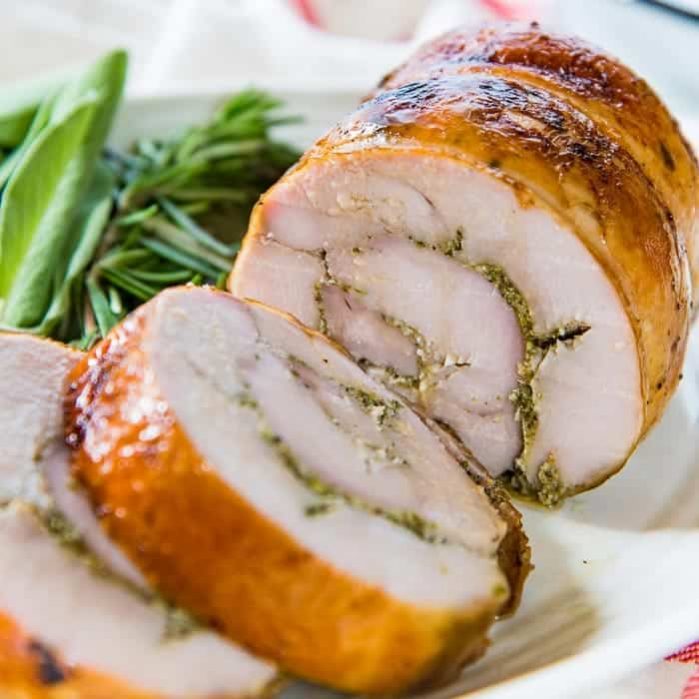
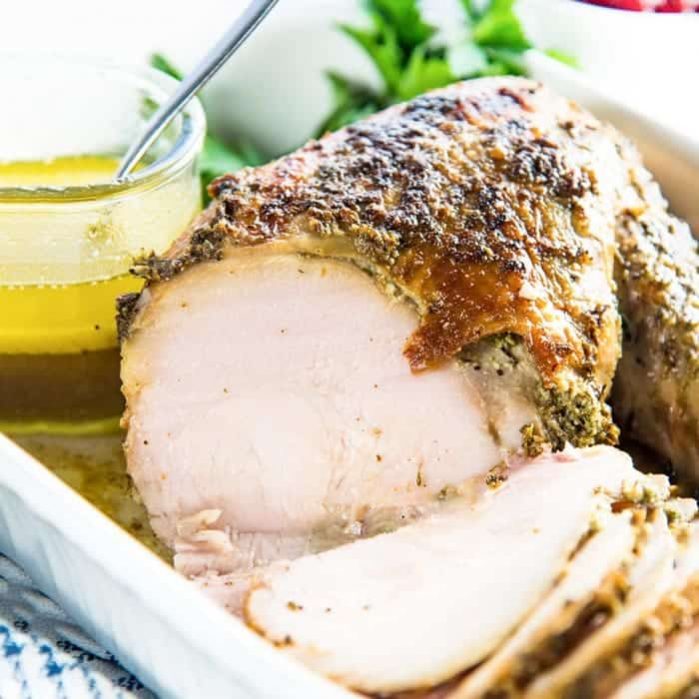
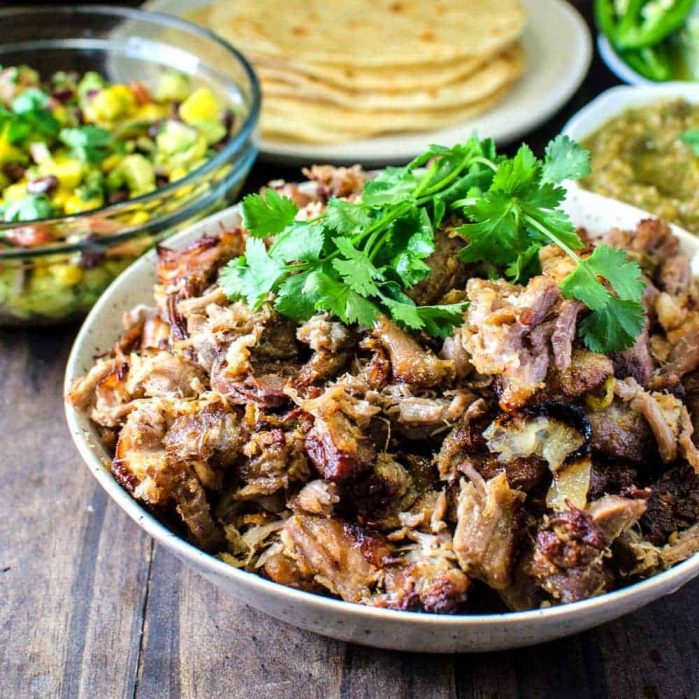
RebeccaS says
What if I want to cook 2 boneless breasts (3 lbs each) at the same time? How should I arrange them? What adjustments to roasting time and temperature if any? Thanks so much—this looks awesome!!
Joyce says
Love this recipe! I never liked breast meat before because it was always so dried out. This recipe is spot on. Thank you. I actually roasted for about 65 minutes until temp reached 150. Removed turkey and rested it. Then cranked up the broiler and completed browning the skin. Will absolutely make again. Flavoring perfect even without the gravy.
Rona says
Wow!!! Finally, it came out perfect, thank you so much for the elaborate explanation, now i’m never going to buy pastrami again. Absolutely delicious and moist . Thank you thank you thank you❣
April says
Thank you for all the tips! Looking forward to making this next week.
Wilhelmina Wessel says
You have great tips and this turkey looks amazing!